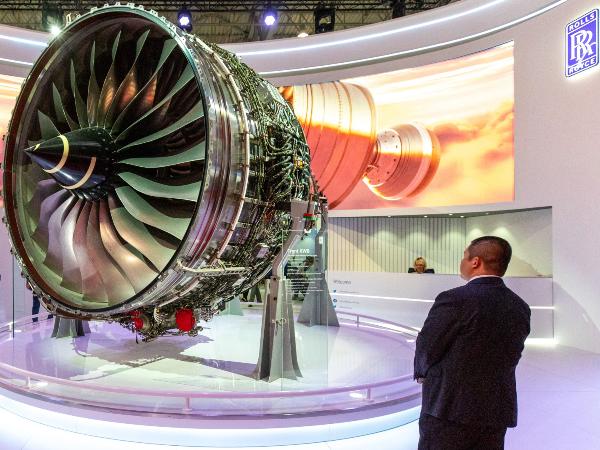Are Rolls-Royce shares still the buying opportunity of the FTSE 100?
Rolls-Royce shares are still hailed the FTSE 100 ‘jewel in the crown’ of British engineering. But the short-term focus will be on cash flow and civil aerospace.
 Source: Bloomberg
Source: Bloomberg
Six months ago, Morgan Stanley judged Rolls-Royce (LON: RR) shares as ‘woefully mispriced,’ with the FTSE 100 company’s earnings recovery ‘much closer than the market has priced in, while earnings and cash flow are directly geared to the next leg of a global aviation recovery.’
At the time, this could have been a sound judgement. Rolls has made exceptional strides forward in technological development, including its world record-breaking all-electric plane, ultra-efficient power gearbox, and politically supported plans to develop small modular nuclear reactors.
But Rolls-Royce’s share price fell from 94p in mid-July to just 66p by 12 October. And this isn’t the first time the FTSE 100 stock has disappointed investors, having fallen by 74% over the past five years and 34% year-to-date.
But it's also up by 17% over the past month to 83.5p. This begs the question: can Rolls-Royce shares still make a claim for the buying opportunity of the FTSE 100?
Rolls-Royce share price: trading update
Last week’s trading update provided investors with some needed good news. The FTSE 100 company lauded its ‘continued recovery,’ with ‘record order intake in Power Systems, large engine flying hours at 65% of 2019 levels in the four months to the end of October and up 36% year to date.’
Perhaps in response to increased geopolitical threats, and specifically to the Ukraine war and Taiwan tensions, Rolls also saw two five-year defence contracts renewed, securing $1.8 billion of continued aftermarket services.
And encouragingly, it has finally completed its €1.6 billion disposal of ITP aero, using the proceeds to repay a £2 billion 2025 UK Finance-backed floating rate loan, that could have become rapidly more expensive as rates rise. Outgoing CEO Warren East enthuses that the reduction of £2 billion of its debt marks a ‘milestone recovery in the strength of our balance sheet, and a clear step on our path back to investment grade in the medium term.’
While Rolls-Royce’s drawn debt has now reduced to £4 billion, the majority matures between 2026 and 2028, and none before 2024. Importantly, the FTSE 100 company has made clear that ‘all drawn debt is on fixed interest rate terms and hedged into GBP executed in 2019 and 2020 during the low interest rate environment. We do not anticipate raising drawn debt for near term loan refinancing.’
East argues that ‘the continued recovery in large engine flying hours, record order intake in Power Systems and a resilience in the Defence business give us confidence in the future.’
 Source: Bloomberg
Source: Bloomberg
FTSE 100: where next for Rolls-Royce shares?
First off, Rolls-Royce has left FY22 guidance unchanged despite rising inflation and the wider cost-of-living crisis. And the CEO thinks the ‘more agile operations and sustainably lower cost base position us well for the uncertain pace of the recovery from the pandemic, market volatility and changes in economic conditions.’
Beyond this, the investment case could be looking promising. The pandemic saw the FTSE 100 company lose billions. Now Rolls is on the verge of breaking even, and could even be cash flow positive by the end of the year.
Further, global defence spending is accelerating, and the FTSE 100 company should stand to benefit both from the high barriers to entry, and government favour by dint of its golden share.
The Power Systems division is seeing ‘continued high levels of demand …driving an exceptionally strong order book, with a record order intake year to date in 2022 and good revenue cover for 2023 and beyond.’ This includes an order for more than 500 mtu engines for the UK's Boxer armoured vehicle and 16 gensets for four new frigates for the German Navy.
And its New Markets sector — including electric projects and small nuclear reactors — has significant future potential, which could one day supercharge revenue.
But civil aerospace — which builds and maintains aircraft engines — is the division responsible for the bulk of Rolls-Royce’s profit. And as the global economy spirals into recession, the FTSE 100 company still needs this sector to recover from the pandemic.
Happily, despite squeezed consumer finances, large engine flying hours have already recovered to 65% of pre-pandemic levels in the four months to October and are up by 36% year-to-date.
As evidenced by IAG’s Q3 results, US and European aviation have largely recovered, while demand in China and Asia remains suppressed due to ongoing coronavirus measures. With whispers circling that Beijing could abandon its ‘zero-covid’ strategy, increased flying hours in the region could translate to a revenue boost in Rolls’ biggest segment.
But there are no dividends on offer until 2023, a condition of its loan terms, and of its negative equity position. This means Rolls-Royce investors are depending on capital appreciation.
A challenge for incoming CEO Tufan Erginbilgic, who hopes to see Rolls-Royce shares restored to their former glory.
Trade and invest in over 17,000 UK, US and global shares from zero commission with us, the UK’s No.1 trading provider.*
Learn more about trading or investing in shares with us, or open an account to get started today.







0 Comments
Recommended Comments
There are no comments to display.
Create an account or sign in to comment
You need to be a member in order to leave a comment
Create an account
Sign up for a new account in our community. It's easy!
Register a new accountSign in
Already have an account? Sign in here.
Sign In Now